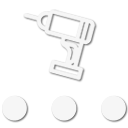
Creator III
This is probably the single most important, but missed by many, thing to keep your cast iron kit in great condition.
The idea is to put a non stick coating on the surface of the iron.
If it's new, or particularly dirty, wash with warm water and mild detergent - the first time should be the only time you ever need to use soapy water.
Once clean, wipe the entire pot with a plain, basic vegetable oil, inside an out.
Place it over the BBQ hot coals (NO FLAMES) and leave it to cook the oil into the iron. Can be repeated 2 or 3 times to ensure a non-stick good layer.
When cooking, make sure the contents are moved around to prevent localised heating and possible sticking.
This can be by stirring, or by moving the pot about to move the contents.
When baking or roasting, a lot of the heat also needs to be on top, so a way of moving coals onto the lid is needed, and if the coals start to loose temperature, be ready to swap them around for consistent heat. Be careful when moving the pot about.
A good pair of gloves will be needed (I use (clean) welding gloves).
Once cooking is finished, leave the pot to cool and add water, then place back on the heat. Never add cold water to a hot cast iron pot - it'll crack.
Or, add water just off the boil to the hot pot and place back on the heat to simmer while you eat your meal.
This will lift any stuck food residue from the seasoned surface. If you do need to scrape any off, use a wooden spoon to avoid damaging the surface of the iron.
Once clean, dry thoroughly - water is your enemy from here on. Once dry, wipe with a paper towel soaked in cooking oil to add another layer of protection.
Look after your Dutch Oven and it will keep you fed for years.
The idea is to put a non stick coating on the surface of the iron.
If it's new, or particularly dirty, wash with warm water and mild detergent - the first time should be the only time you ever need to use soapy water.
Once clean, wipe the entire pot with a plain, basic vegetable oil, inside an out.
Place it over the BBQ hot coals (NO FLAMES) and leave it to cook the oil into the iron. Can be repeated 2 or 3 times to ensure a non-stick good layer.
When cooking, make sure the contents are moved around to prevent localised heating and possible sticking.
This can be by stirring, or by moving the pot about to move the contents.
When baking or roasting, a lot of the heat also needs to be on top, so a way of moving coals onto the lid is needed, and if the coals start to loose temperature, be ready to swap them around for consistent heat. Be careful when moving the pot about.
A good pair of gloves will be needed (I use (clean) welding gloves).
Once cooking is finished, leave the pot to cool and add water, then place back on the heat. Never add cold water to a hot cast iron pot - it'll crack.
Or, add water just off the boil to the hot pot and place back on the heat to simmer while you eat your meal.
This will lift any stuck food residue from the seasoned surface. If you do need to scrape any off, use a wooden spoon to avoid damaging the surface of the iron.
Once clean, dry thoroughly - water is your enemy from here on. Once dry, wipe with a paper towel soaked in cooking oil to add another layer of protection.
Look after your Dutch Oven and it will keep you fed for years.






